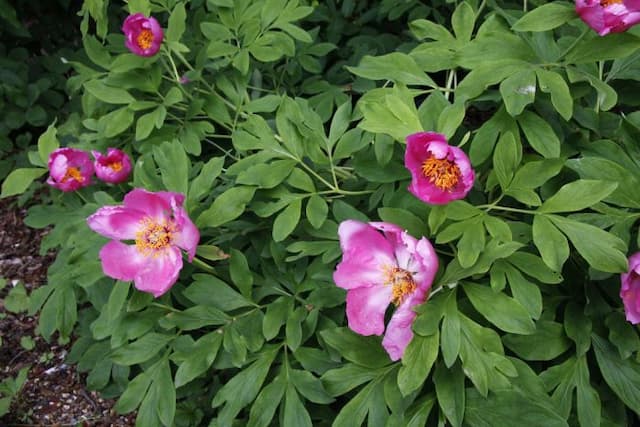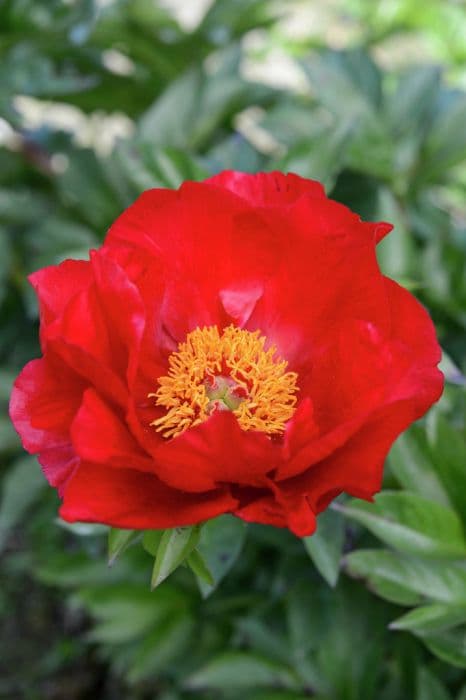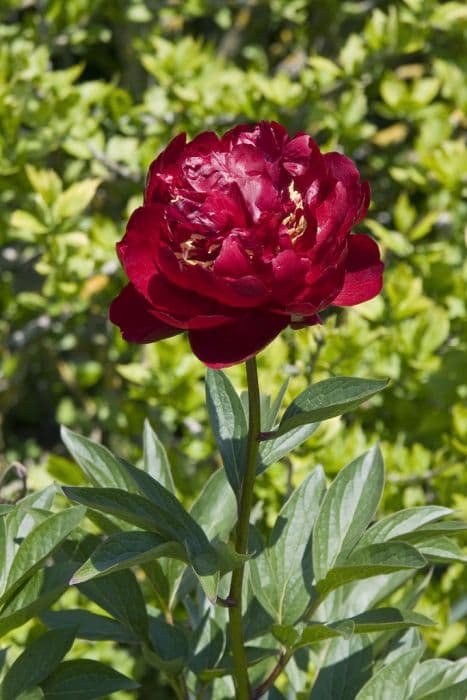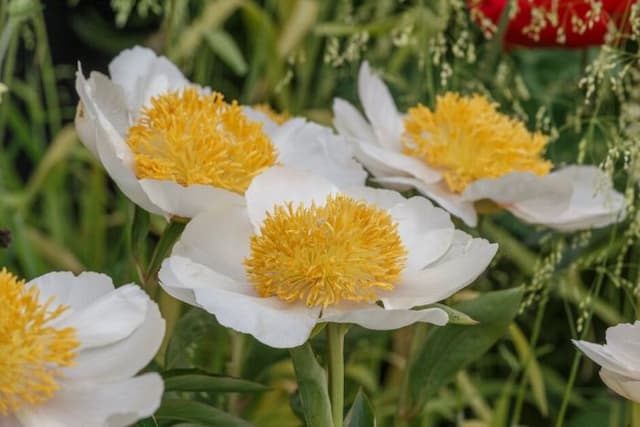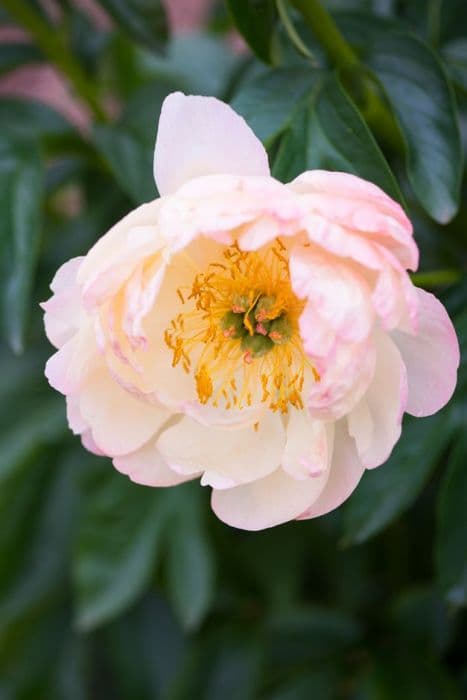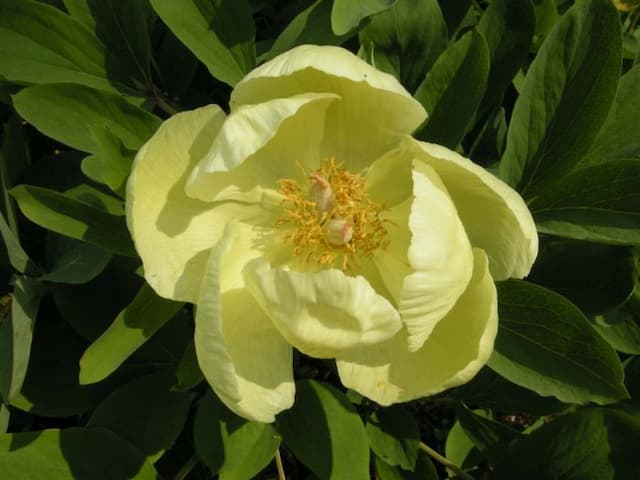Peony Paeonia lactiflora 'Nice Gal'

ABOUT
The 'Nice Gal' peony is a cherished flowering plant, most commonly recognized for its large, full blossoms that showcase an alluring blend of light to medium pink petals. The petals are typically layered and densely packed, giving the flower a lush, rounded appearance. The center of the bloom often houses a group of golden yellow stamens, adding a striking contrast to the pink petals and drawing attention to the heart of the flower. The overall look of the 'Nice Gal' peony is one of elegance and softness, with the petals sometimes exhibiting a delicate ruffle at their edges, providing a sense of depth and texture. The flowers emit a gentle fragrance that is appealing and subtly sweet, which makes them a favorite for gardens and floral arrangements. The foliage of the 'Nice Gal' peony consists of deep green leaves that have a glossy finish and a leathery texture. The leaves are divided into leaflets, with each compound leaf being quite substantial in size and contributing to the lush appearance of the plant. The contrast between the dark foliage and the bright blooms creates a striking visual impact when the plant is in full bloom. The 'Nice Gal' peony is a standout plant in any garden setting, with its blooms coming into their full glory in late spring to early summer, inviting admirers to gaze upon their beauty and enjoy their light, pleasant scent. The plant's overall form is that of a neat, bushy mound that serves as the perfect backdrop for its showy flowers.
About this plant
 Names
NamesFamily
Paeoniaceae
Synonyms
Chinese Peony, Common Garden Peony
Common names
Paeonia lactiflora.
 Toxicity
ToxicityTo humans
Peony, specifically the Paeonia lactiflora 'Nice Gal', is generally not considered toxic to humans. In traditional medicine, parts of peonies have even been used for therapeutic purposes. However, consuming any part of the plant in large quantities might lead to stomach upset or diarrhea due to its mildly diuretic and laxative properties. Accidental ingestion typically does not lead to severe poisoning.
To pets
Peony, including Paeonia lactiflora 'Nice Gal', can be toxic to pets if ingested. The main concern for cats and dogs when ingesting peonies are gastrointestinal irritations which may lead to symptoms such as vomiting or diarrhea. It is advisable to keep pets away from peonies, and if ingestion occurs, watch for these symptoms and consult a veterinarian if they persist or are severe.
 Characteristics
CharacteristicsLife cycle
Perennials
Foliage type
Deciduous
Color of leaves
Green
Flower color
Pink
Height
2-3 feet (0.6-0.9 meters)
Spread
2-3 feet (0.6-0.9 meters)
Plant type
Herb
Hardiness zones
3-8
Native area
Asia
Benefits
 General Benefits
General Benefits- Aesthetic Appeal: Paeonia lactiflora 'Nice Gal', commonly known as peony, offers large, attractive blooms that enhance the beauty of gardens and landscapes.
- Variety of Colors: Peonies come in a range of colors, allowing for diverse design options in garden settings.
- Longevity: Peonies are known for their long lifespan, often living for decades and can be considered a long-term investment in a garden.
- Seasonal Interest: They bloom in late spring to early summer, providing a seasonal focal point in the garden.
- Cut Flowers: Peonies are excellent for cut flower arrangements, adding elegance to indoor settings.
- Fragrance: Many peony varieties have a pleasant fragrance, which can enhance the sensory experience of a garden.
- Easy to Grow: Peonies are hardy and relatively easy to grow, making them suitable for gardeners of various skill levels.
- Drought Tolerance: Once established, peonies can tolerate periods of drought, making them suitable for gardens in drier climates.
- Deer and Rabbit Resistance: Peonies are generally not preferred by deer and rabbits, reducing the risk of damage from these animals.
- Attract Pollinators: The flowers can attract bees and other pollinators, supporting local biodiversity.
 Medical Properties
Medical Properties- Anti-inflammatory: Paeonia lactiflora, known commonly as the Chinese peony, has been used in traditional medicine for its potential anti-inflammatory properties.
- Analgesic: Components of the Chinese peony root have been utilized for their analgesic properties to help alleviate pain.
- Immunomodulatory: Some studies suggest that extracts from Paeonia lactiflora may influence the immune system, which can be beneficial for immunoregulation.
- Antispasmodic: The Chinese peony has been used to help relieve muscle spasms.
- Antioxidant: There are indications that this plant has antioxidant properties, potentially protecting cells from oxidative stress.
 Air-purifying Qualities
Air-purifying QualitiesThis plant is not specifically known for air purifying qualities.
 Other Uses
Other Uses- Art and Craft Supplies: Petals of the peony can be pressed and used in creating botanical art pieces or in scrapbooks, where their vibrant colors and textures add a unique touch.
- Vegetable Dye: The roots and petals of peonies can be boiled to produce a natural red or pink dye for fabric or handmade paper.
- Perfumery: Peony petals are sometimes used in perfumery for their soft, floral fragrance, contributing to the scent profile of many luxury perfumes.
- Floral Water: By distilling peony petals, a lightly scented floral water can be made, which can be used as a refreshing linen spray or a gentle facial toner.
- Gourmet Culinary Ingredient: The petals of the peony, when free of pesticides, can be crystallized with sugar for a decorative and edible garnish on desserts.
- Cultural Symbols: Peony flowers are used as symbols in various cultural ceremonies, representing wealth, honor, and high social status, particularly in Asian traditions.
- Edible Flowers: The petals of the peony can be added to salads or used as garnish to provide a pop of color and a subtle, fresh flavor to various dishes.
- Wedding Decor: Because of their lush and full appearance, peony flowers are popular choices for bridal bouquets and wedding decorations, symbolizing a happy marriage.
- Gardening Companion Plant: Peonies can be planted alongside vegetables to help attract pollinators to the garden, thus aiding in the pollination of vegetable crops.
- Potpourri Ingredient: Dried peony petals can be incorporated into potpourri mixtures, adding a floral scent and visual appeal to the mix.
Interesting Facts
 Feng Shui
Feng ShuiThe Peony is often used in Feng Shui to promote romance and prosperity; it is considered a symbol of beauty, affection, and the feminine mystique. Place Peonies in the southwest sector of the home or garden to enhance love and marriage prospects.
 Zodiac Sign Compitability
Zodiac Sign CompitabilityThe Peony is not used in astrology practice.
 Plant Symbolism
Plant Symbolism- Wealth and Honor: The peony, traditionally regarded as a symbol of wealth and prosperity, is often associated with high status and honor in society.
- Romance and Love: With its lush, full blooms, the peony represents romance and amorous feelings, embodying the blissful state of being in love.
- Beauty in all forms: The peony's stunning petals are a testament to natural beauty. This symbolism extends to human beauty, as well as the beauty in art and culture.
- Feminine Power: Often tied to female beauty and power, the peony reflects attributes such as resilience and the ability to thrive despite challenges.
- Compassion: The peony can be a symbol of compassion, signaling empathy, and concern for others due to its nurturing aspect as a well-loved, nurturing flower.
- Good Fortune and Happiness: In many cultures, peonies are considered a good omen, representing a happy life or marriage, and the promise of good fortune in the future.
 Water
WaterThe peony, specifically the 'Nice Gal' variety, should be watered deeply once a week, allowing the soil to become slightly dry between waterings. During the growing season, aim to provide about one inch of water per week, which equates to about half a gallon for a standard sized plant. In hotter, dryer periods, this amount may need to increase to ensure the soil remains moist but not waterlogged. Overhead watering should be avoided to prevent leaf diseases; instead, water at the base of the plant. Reduce watering after the peonies have bloomed and as they go dormant in late summer to prepare them for winter.
 Light
LightPeonies thrive in full sun to part shade conditions. The 'Nice Gal' variety will do best with at least six hours of direct sunlight per day. Ideal placement is in an area that receives morning sun, which is gentle and less likely to cause scorching, with some protection during the hottest part of the afternoon. Avoid deep shade as it can significantly reduce blooming.
 Temperature
TemperaturePeonies like 'Nice Gal' prefer temperate climates with temperatures ranging between 65°F and 75°F for optimal growth. They are cold hardy and can survive winter temperatures down to about -20°F. Peonies also require a period of winter chill to enter dormancy and set buds for the next season's blooms, so they may struggle in regions where temperatures do not drop below 40°F for an extended period.
 Pruning
PruningPrune 'Nice Gal' peonies to remove spent flowers after they bloom to maintain a neat appearance and prevent seed formation, which can divert energy from next year's growth. In fall, once the foliage has yellowed, cut back the stems to about three inches above ground level to prepare the plant for winter and reduce the risk of fungal diseases. Prune annually to ensure robust health and abundant blooms for the following season.
 Cleaning
CleaningAs needed
 Soil
SoilPeony 'Nice Gal' thrives in well-drained, fertile soil with a pH of 6.5 to 7.0. A mix of garden loam, peat moss, and perlite can provide proper drainage and nutrients. Organic matter, like compost, should be incorporated to enhance soil structure and fertility.
 Repotting
RepottingPeony 'Nice Gal' seldom needs repotting as it prefers to be undisturbed. Once planted, peonies can remain in the same spot for many years. Dividing or moving is only necessary if the plant becomes too crowded or needs rejuvenation, which is typically every 10-15 years.
 Humidity & Misting
Humidity & MistingPeony 'Nice Gal' is tolerant of a wide range of humidity levels and does not require any specific humidity conditions. Peonies generally prefer outdoor environments where the humidity is naturally regulated.
 Suitable locations
Suitable locationsIndoor
Ensure bright light, cool temps, and ample space.
Outdoor
Plant in full sun, enriched soil, protect from harsh winds.
Hardiness zone
3-8 USDA
 Life cycle
Life cycleThe Paeonia lactiflora 'Nice Gal', commonly known as Chinese Peony, begins its life cycle when seeds are sown in late fall, allowing them to undergo a required period of cold stratification. As spring arrives, the seeds germinate and sprouts emerge from the soil, developing into small seedlings with a few leaves. The plant then enters a vegetative stage, during which it grows larger each year, forming a bushy mound of dark green, divided foliage. By late spring to early summer, the peony produces large, showy flowers that are often fragrant, attracting pollinators for reproduction. After flowering, seed pods may form, and once mature, they crack open to release seeds; the plant also invests energy into expanding its underground tuberous roots during this time. As autumn approaches, the foliage dies back, and the peony enters a period of dormancy until the following spring.
 Propogation
PropogationPropogation time
Late winter-early spring
Paeonia lactiflora 'Nice Gal', commonly known as the Chinese peony, is most commonly propagated through division, allowing gardeners to create new plants that are genetically identical to the parent. The best time for dividing peonies is in the fall, when the plant has already gone dormant, usually in late September or October. To propagate by division, carefully dig up the peony clump, taking care not to damage the roots excessively. Then, using a sharp knife or spade, divide the clump into sections ensuring each has at least 3 to 5 eyes, which are the small red buds on the roots that will become next year's shoots. After division, the plants should be immediately replanted at the proper depth, which is usually no more than 2 inches (5 centimeters) of soil over the eyes, in well-drained soil with access to full or partial sunlight. Adequate spacing is important, with each division ideally having about 3 feet (almost 1 meter) of space to allow for mature growth. Watering should be done gently, ensuring the divisions settle in without being waterlogged.
